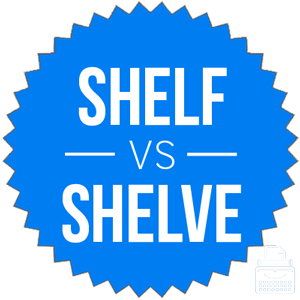The words shelf and shelve are confusing. They are different parts of speech, but many English users are incautious, and use them interchangeably.
To make matters worse, the word shelves can be both a noun and a verb, and it is related to both shelf and shelve.
What’s a writer to do? Since you’ve made it this far, you might as well continue reading to learn more about these confusing words.
What is the Difference Between Shelf and Shelve?
In this post, I will compare shelve vs. shelf and use each word in a few example sentences.
You will be able to see the words in the context of complete sentences. Then, I will talk about a mnemonic device that allows you to choose shelve or shelf correctly every time.
When to Use Shelf
 What does shelf mean? Shelf is a noun. It is a horizontal surface upon which things can be placed. The plural form of shelf is shelves; multiple shelves might be collectively called shelving.
What does shelf mean? Shelf is a noun. It is a horizontal surface upon which things can be placed. The plural form of shelf is shelves; multiple shelves might be collectively called shelving.
A bookshelf is a structure that has several shelves arranged vertically to maximize storage space in a small footprint. A bathroom shelf is a shelf in a bathroom.
Here are a few more examples:
- If you look on the third shelf in the linen closet, you will find clean towels and a set of fresh sheets for the guest room.
- Grandma placed her favorite trinkets on a high shelf in the living room, where hyperactive grandchildren could not reach them.
- For New York, Ms. Sparrow said she flew in about nine tons of fake goods, including dozens of cigarette packs — Marlboros, Pall Malls and other American brands — all sewn from colored felt; shelf after shelf of Doritos, also in felt; actual soda coolers and store shelves with felt covering every surface. –The New York Times
When to Use Shelve
 What does shelve mean? The word shelve is a verb. It means to put things on a shelf, where shelf is the noun discussed above. It sometimes also means to decide not to move forward with something.
What does shelve mean? The word shelve is a verb. It means to put things on a shelf, where shelf is the noun discussed above. It sometimes also means to decide not to move forward with something.
Here are some examples:
- “I think we are going to shelve this idea,” said the chairman after none of the other board members could come to an agreement.
- “Julia can shelve the new inventory while Mark sweeps the floors,” said the manager of the grocery store.
- But after nearly a decade of research, Apple quietly shelved plans to make such a set more than a year ago, according to people familiar with the matter. –The Wall Street Journal
Shelve cannot be used as a singular noun. Some English speakers might use shelve in place of shelf in informal conversation, but this usage is not considered correct.
Misusing shelve for shelf is probably a backformation from the plural shelves. Since many nouns become plural by adding the suffix -s, some speakers might mistakenly think shelve is the same way.
The confusion could also arise from the word shelves, which can be both a noun and the third person singular conjugation of the verb shelve.
Trick to Remember the Difference
 Shelf is a noun and shelve is a verb. Even though the plural form of shelf is shelves, shelve is never a singular noun.
Shelf is a noun and shelve is a verb. Even though the plural form of shelf is shelves, shelve is never a singular noun.
What’s an easy way to remember shelf vs. shelve?
Since shelve and verb both contain the letter V, remembering that shelve is a verb should be a relatively simple proposition.
Summary
Is it shelf or shelve? A shelf is a raised, horizontal surface used for storing things. The word shelve is a verb that means to decide not to move forward with something or to put things on a shelf. The two words are never interchangeable, although shelves is both the plural form of shelf and a possible conjugation of shelve.
In short,
- Use shelf only as a noun.
- Use shelve only as a verb.
Contents
